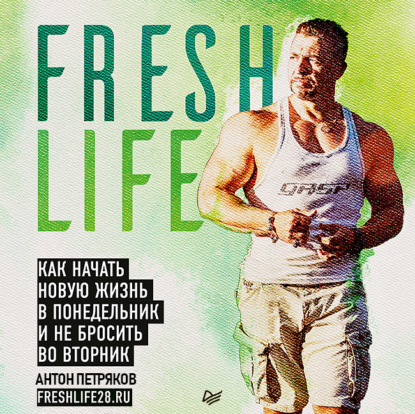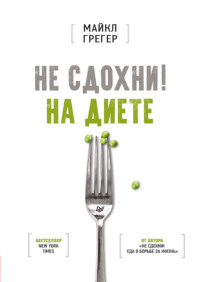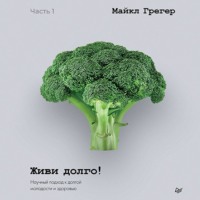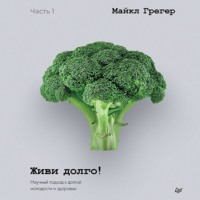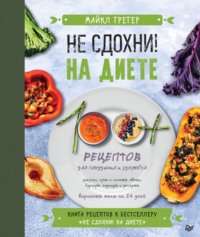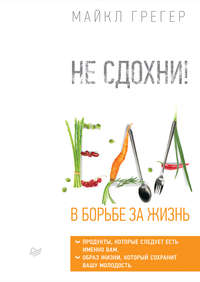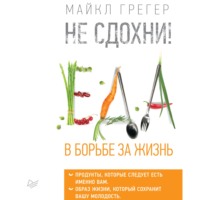
Полная версия
Живи долго! Научный подход к долгой молодости и здоровью
1631
Chai SC, Davis K, Zhang Z, Zha L, Kirschner KF. Effects of tart cherry juice on biomarkers of inflammation and oxidative stress in older adults. Nutrients. 2019;11(2):228. https://pubmed.ncbi.nlm.nih.gov/30678193/
1632
Dourado GKZS, Cesar TB. Investigation of cytokines, oxidative stress, metabolic, and inflammatory biomarkers after orange juice consumption by normal and overweight subjects. Food Nutr Res. 2015;59(1):28147. https://pubmed.ncbi.nlm.nih.gov/26490535/
1633
Shema-Didi L, Sela S, Ore L, et al. One year of pomegranate juice intake decreases oxidative stress, inflammation, and incidence of infections in hemodialysis patients: a randomized placebo-controlled trial. Free Radic Biol Med. 2012;53(2):297–304. https://pubmed.ncbi.nlm.nih.gov/22609423/
1634
Ghavipour M, Sotoudeh G, Ghorbani M. Tomato juice consumption improves blood antioxidative biomarkers in overweight and obese females. Clin Nutr. 2015;34(5):805–9. https://pubmed.ncbi.nlm.nih.gov/25466953/
1635
Shyam R, Singh SN, Vats P, et al. Wheat grass supplementation decreases oxidative stress in healthy subjects: a comparative study with spirulina. J Altern Complement Med. 2007;13(8):789–91. https://pubmed.ncbi.nlm.nih.gov/17983333/
1636
Basu A, Betts NM, Ortiz J, Simmons B, Wu M, Lyons TJ. Low-calorie cranberry juice decreases lipid oxidation and increases plasma antioxidant capacity in women with metabolic syndrome. Nutr Res. 2011;31(3):190–6. https://pubmed.ncbi.nlm.nih.gov/21481712/
1637
de Lima Tavares Toscano L, Silva AS, de França ACL, et al. A single dose of purple grape juice improves physical performance and antioxidant activity in runners: a randomized, crossover, double-blind, placebo study. Eur J Nutr. 2020;59(7):2997–3007. https://pubmed.ncbi.nlm.nih.gov/31732851/
1638
Cao G, Russell RM, Lischner N, Prior RL. Serum antioxidant capacity is increased by consumption of strawberries, spinach, red wine or vitamin C in elderly women. J Nutr. 1998;128(12):2383–90. https://pubmed.ncbi.nlm.nih.gov/9868185/
1639
Ursini F, Zamburlini A, Cazzolato G, Maiorino M, Bon GB, Sevanian A. Postprandial plasma lipid hydroperoxides: a possible link between diet and atherosclerosis. Free Radic Biol Med. 1998;25(2):250–2. https://pubmed.ncbi.nlm.nih.gov/9667503/
1640
Caccetta RAA, Burke V, Mori TA, Beilin LJ, Puddey IB, Croft KD. Red wine polyphenols, in the absence of alcohol, reduce lipid peroxidative stress in smoking subjects. Free Radic Biol Med. 2001;30(6):636–42. https://pubmed.ncbi.nlm.nih.gov/11295361/
1641
Meagher EA, Barry OP, Burke A, et al. Alcohol-induced generation of lipid peroxidation products in humans. J Clin Invest. 1999;104(6):805–13. https://pubmed.ncbi.nlm.nih.gov/10491416/
1642
Xue KX, Wang S, Ma GJ, et al. Micronucleus formation in peripheral-blood lymphocytes from smokers and the influence of alcohol- and tea-drinking habits. Int J Cancer. 1992;50(5):702–5. https://pubmed.ncbi.nlm.nih.gov/1544703/
1643
Bloomer RJ, Trepanowski JF, Farney TM. Influence of acute coffee consumption on postprandial oxidative stress. Nutr Metab Insights. 2013;6:35–42. https://pubmed.ncbi.nlm.nih.gov/23935371/
1644
Takahashi M, Miyashita M, Suzuki K, et al. Acute ingestion of catechin-rich green tea improves postprandial glucose status and increases serum thioredoxin concentrations in postmenopausal women. Br J Nutr. 2014;112(9):1542–50. https://pubmed.ncbi.nlm.nih.gov/25230741/
1645
Leenen R, Roodenburg AJ, Tijburg LB, Wiseman SA. A single dose of tea with or without milk increases plasma antioxidant activity in humans. Eur J Clin Nutr. 2000;54(1):87–92. https://pubmed.ncbi.nlm.nih.gov/10694777/
1646
Rashidinejad A, Birch EJ, Sun-Waterhouse D, Everett DW. Addition of milk to tea infusions: helpful or harmful? Evidence from in vitro and in vivo studies on antioxidant properties. Crit Rev Food Sci Nutr. 2017;57(15):3188–96. https://pubmed.ncbi.nlm.nih.gov/26517348/
1647
Ho CK, Choi SW, Siu PM, Benzie IFF. Effects of single dose and regular intake of green tea (Camellia sinensis) on DNA damage, DNA repair, and heme oxygenase-1 expression in a randomized controlled human supplementation study. Mol Nutr Food Res. 2014;58(6):1379–83. https://pubmed.ncbi.nlm.nih.gov/24585444/
1648
Han KC, Wong WC, Benzie IFF. Genoprotective effects of green tea (Camellia sinensis) in human subjects: results of a controlled supplementation trial. Br J Nutr. 2011;105(2):171–9. https://pubmed.ncbi.nlm.nih.gov/20807462/
1649
Dias TR, Alves MG, Tomás GD, Socorro S, Silva BM, Oliveira PF. White tea as a promising antioxidant medium additive for sperm storage at room temperature: a comparative study with green tea. J Agric Food Chem. 2014;62(3):608–17. https://pubmed.ncbi.nlm.nih.gov/24372402/
1650
Choi SW, Yeung VTF, Collins AR, Benzie IFF. Redox-linked effects of green tea on DNA damage and repair, and influence of microsatellite polymorphism in HMOX-1: results of a human intervention trial. Mutagenesis. 2015;30(1):129–37. https://pubmed.ncbi.nlm.nih.gov/25527735/
1651
Leaf DA, Kleinman MT, Hamilton M, Deitrick RW. The exercise-induced oxidative stress paradox: the effects of physical exercise training. Am J Med Sci. 1999;317(5):295–300. https://pubmed.ncbi.nlm.nih.gov/10334116/
1652
Mastaloudis A, Yu TW, O’Donnell RP, Frei B, Dashwood RH, Traber MG. Endurance exercise results in DNA damage as detected by the comet assay. Free Radic Biol Med. 2004;36(8):966–75. https://pubmed.ncbi.nlm.nih.gov/15059637/
1653
Vollaard NBJ, Shearman JP, Cooper CE. Exercise-induced oxidative stress: myths, realities and physiological relevance. Sports Med. 2005;35(12):1045–62. https://pubmed.ncbi.nlm.nih.gov/16336008/
1654
Mastaloudis A, Yu TW, O’Donnell RP, Frei B, Dashwood RH, Traber MG. Endurance exercise results in DNA damage as detected by the comet assay. Free Radic Biol Med. 2004;36(8):966–75. https://pubmed.ncbi.nlm.nih.gov/15059637/
1655
Fisher-Wellman K, Bloomer RJ. Acute exercise and oxidative stress: a 30 year history. Dyn Med. 2009;8:1. https://pubmed.ncbi.nlm.nih.gov/19144121/
1656
Ristow M, Zarse K, Oberbach A, et al. Antioxidants prevent health-promoting effects of physical exercise in humans. Proc Natl Acad Sci U S A. 2009;106(21):8665–70. https://pubmed.ncbi.nlm.nih.gov/19433800/
1657
Braakhuis AJ. Effect of vitamin C supplements on physical performance. Curr Sports Med Rep. 2012;11(4):180–4. https://pubmed.ncbi.nlm.nih.gov/22777327/
1658
Kashi DS, Shabir A, Da Boit M, Bailey SJ, Higgins MF. The efficacy of administering fruit-derived polyphenols to improve health biomarkers, exercise performance and related physiological responses. Nutrients. 2019;11(10):E2389. https://pubmed.ncbi.nlm.nih.gov/31591287/
1659
Van der Avoort CMT, Van Loon LJC, Hopman MTE, Verdijk LB. Increasing vegetable intake to obtain the health promoting and ergogenic effects of dietary nitrate. Eur J Clin Nutr. 2018;72(11):1485–9. https://pubmed.ncbi.nlm.nih.gov/29559721/
1660
Trapp D, Knez W, Sinclair W. Could a vegetarian diet reduce exercise-induced oxidative stress? A review of the literature. J Sports Sci. 2010;28(12):1261–8. https://pubmed.ncbi.nlm.nih.gov/20845212/
1661
Lyall KA, Hurst SM, Cooney J, et al. Short-term blackcurrant extract consumption modulates exercise-induced oxidative stress and lipopolysaccharide-stimulated inflammatory responses. Am J Physiol Regul Integr Comp Physiol. 2009;297(1):R70–81. https://pubmed.ncbi.nlm.nih.gov/19403859/
1662
Funes L, Carrera-Quintanar L, Cerdán-Calero M, et al. Effect of lemon verbena supplementation on muscular damage markers, proinflammatory cytokines release and neutrophils’ oxidative stress in chronic exercise. Eur J Appl Physiol. 2011;111(4):695–705. https://pubmed.ncbi.nlm.nih.gov/20967458/
1663
Ghezzi P, Jaquet V, Marcucci F, Schmidt HHHW. The oxidative stress theory of disease: levels of evidence and epistemological aspects. Br J Pharmacol. 2017;174(12):1784–96. https://pubmed.ncbi.nlm.nih.gov/27425643/
1664
Scudellari M. The science myths that will not die. Nature. 2015;528(7582):322–5. https://pubmed.ncbi.nlm.nih.gov/26672537/
1665
Peng C, Wang X, Chen J, et al. Biology of ageing and role of dietary antioxidants. Biomed Res Int. 2014;2014:831841. https://pubmed.ncbi.nlm.nih.gov/24804252/
1666
Milisav I, Ribaric S, Poljsak B. Antioxidant vitamins and ageing. Subcell Biochem. 2018;90:1–23. https://pubmed.ncbi.nlm.nih.gov/30779004/
1667
Smejkal GB, Kakumanu S. Enzymes and their turnover numbers. Expert Rev Proteom. 2019;16(7):543–4. https://pubmed.ncbi.nlm.nih.gov/31220960/
1668
Raghunath A, Sundarraj K, Nagarajan R, et al. Antioxidant response elements: discovery, classes, regulation and potential applications. Redox Biol. 2018;17:297–314. https://pubmed.ncbi.nlm.nih.gov/29775961/
1669
Zang H, Mathew RO, Cui T. The dark side of Nrf2 in the heart. Front Physiol. 2020;11:722. https://pubmed.ncbi.nlm.nih.gov/32733266/
1670
Brandes MS, Gray NE. NRF2 as a therapeutic target in neurodegenerative diseases. ASN Neuro. 2020;12:1759091419899782. https://pubmed.ncbi.nlm.nih.gov/31964153/
1671
Sharma V, Kaur A, Singh TG. Counteracting role of nuclear factor erythroid 2-related factor 2 pathway in Alzheimer’s disease. Biomed Pharmacother. 2020;129:110373. https://pubmed.ncbi.nlm.nih.gov/32603894/
1672
Yuan H, Xu Y, Luo Y, Wang NX, Xiao JH. Role of Nrf2 in cell senescence regulation. Mol Cell Biochem. 2021;476(1):247–59. https://pubmed.ncbi.nlm.nih.gov/32918185/
1673
Raghunath A, Sundarraj K, Nagarajan R, et al. Antioxidant response elements: discovery, classes, regulation and potential applications. Redox Biol. 2018;17:297–314. https://pubmed.ncbi.nlm.nih.gov/29775961/
1674
Raghunath A, Sundarraj K, Nagarajan R, et al. Antioxidant response elements: discovery, classes, regulation and potential applications. Redox Biol. 2018;17:297–314. https://pubmed.ncbi.nlm.nih.gov/29775961/
1675
Ferguson LR, Schlothauer RC. The potential role of nutritional genomics tools in validating high health foods for cancer control: broccoli as example. Mol Nutr Food Res. 2012;56(1):126–46. https://pubmed.ncbi.nlm.nih.gov/22147677/
1676
Sun Y, Yang T, Leak RK, Chen J, Zhang F. Preventive and protective roles of dietary Nrf2 activators against central nervous system diseases. CNS Neurol Disord Drug Targets. 2017;16(3):326–38. https://pubmed.ncbi.nlm.nih.gov/28042770/
1677
Yang L, Palliyaguru DL, Kensler TW. Frugal chemoprevention: targeting Nrf2 with foods rich in sulforaphane. Semin Oncol. 2016;43(1):146–53. https://pubmed.ncbi.nlm.nih.gov/26970133/
1678
Qu Z, Sun J, Zhang W, Yu J, Zhuang C. Transcription factor NRF2 as a promising therapeutic target for Alzheimer’s disease. Free Radic Biol Med. 2020;159:87–102. https://pubmed.ncbi.nlm.nih.gov/32730855/
1679
Lewis KN, Mele J, Hayes JD, Buffenstein R. Nrf2, a guardian of healthspan and gatekeeper of species longevity. Integr Comp Biol. 2010;50(5):829–43. https://pubmed.ncbi.nlm.nih.gov/21031035/
1680
Tullet JMA, Hertweck M, An JH, et al. Direct inhibition of the longevity-promoting factor SKN-1 by insulin-like signaling in C. elegans. Cell. 2008;132(6):1025–38. https://pubmed.ncbi.nlm.nih.gov/18358814/
1681
Sykiotis GP, Bohmann D. Keap1/Nrf2 signaling regulates oxidative stress tolerance and lifespan in Drosophila. Dev Cell. 2008;14(1):76–85. https://pubmed.ncbi.nlm.nih.gov/18194654/
1682
Lewis KN, Wason E, Edrey YH, Kristan DM, Nevo E, Buffenstein R. Regulation of Nrf2 signaling and longevity in naturally long-lived rodents. Proc Natl Acad Sci U S A. 2015;112(12):3722–7. https://pubmed.ncbi.nlm.nih.gov/25775529/
1683
Yu C, Li Y, Holmes A, et al. RNA sequencing reveals differential expression of mitochondrial and oxidation reduction genes in the long-lived naked mole-rat when compared to mice. PLoS ONE. 2011;6(11):e26729. https://pubmed.ncbi.nlm.nih.gov/22073188/
1684
Lewis KN, Wason E, Edrey YH, Kristan DM, Nevo E, Buffenstein R. Regulation of Nrf2 signaling and longevity in naturally long-lived rodents. Proc Natl Acad Sci U S A. 2015;112(12):3722–7. https://pubmed.ncbi.nlm.nih.gov/25775529/
1685
Andziak B, O’Connor TP, Buffenstein R. Antioxidants do not explain the disparate longevity between mice and the longest-living rodent, the naked mole-rat. Mech Ageing Dev. 2005;126(11):1206–12. https://pubmed.ncbi.nlm.nih.gov/16087218/
1686
Lewis KN, Wason E, Edrey YH, Kristan DM, Nevo E, Buffenstein R. Regulation of Nrf2 signaling and longevity in naturally long-lived rodents. Proc Natl Acad Sci U S A. 2015;112(12):3722–7. https://pubmed.ncbi.nlm.nih.gov/25775529/
1687
Yuan H, Xu Y, Luo Y, Wang NX, Xiao JH. Role of Nrf2 in cell senescence regulation. Mol Cell Biochem. 2021;476(1):247–59. https://pubmed.ncbi.nlm.nih.gov/32918185/
1688
Zhou L, Zhang H, Davies KJA, Forman HJ. Aging-related decline in the induction of Nrf2-regulated antioxidant genes in human bronchial epithelial cells. Redox Biol. 2018;14:35–40. https://pubmed.ncbi.nlm.nih.gov/28863281/
1689
Mallard AR, Spathis JG, Coombes JS. Nuclear factor (erythroid-derived 2)-like 2 (Nrf2) and exercise. Free Radic Biol Med. 2020;160:471–9. https://pubmed.ncbi.nlm.nih.gov/32871230/
1690
Zhang DD, Chapman E. The role of natural products in revealing NRF2 function. Nat Prod Rep. 2020;37(6):797–826. https://pubmed.ncbi.nlm.nih.gov/32400766/
1691
Su X, Jiang X, Meng L, Dong X, Shen Y, Xin Y. Anticancer activity of sulforaphane: the epigenetic mechanisms and the Nrf2 signaling pathway. Oxid Med Cell Longev. 2018;2018:5438179. https://pubmed.ncbi.nlm.nih.gov/29977456/
1692
Bose C, Alves I, Singh P, et al. Sulforaphane prevents age-associated cardiac and muscular dysfunction through Nrf2 signaling. Aging Cell. 2020;19(11):e13261. https://pubmed.ncbi.nlm.nih.gov/33067900/
1693
Kubo E, Chhunchha B, Singh P, Sasaki H, Singh DP. Sulforaphane reactivates cellular antioxidant defense by inducing Nrf2/ARE/Prdx6 activity during aging and oxidative stress. Sci Rep. 2017;7:14130. https://pubmed.ncbi.nlm.nih.gov/29074861/
1694
Yuan H, Xu Y, Luo Y, Wang NX, Xiao JH. Role of Nrf2 in cell senescence regulation. Mol Cell Biochem. 2021;476(1):247–59. https://pubmed.ncbi.nlm.nih.gov/32918185/
1695
Riso P, Martini D, Møller P, et al. DNA damage and repair activity after broccoli intake in young healthy smokers. Mutagenesis. 2010;25(6):595–602. https://pubmed.ncbi.nlm.nih.gov/20713433/
1696
Hoelzl C, Glatt H, Meinl W, et al. Consumption of Brussels sprouts protects peripheral human lymphocytes against 2-amino-1-methyl-6-phenylimidazo[4,5-b]pyridine (PhIP) and oxidative DNA-damage: results of a controlled human intervention trial. Mol Nutr Food Res. 2008;52(3):330–41. https://pubmed.ncbi.nlm.nih.gov/18293303/
1697
Egner PA, Chen JG, Zarth AT, et al. Rapid and sustainable detoxication of airborne pollutants by broccoli sprout beverage: results of a randomized clinical trial in China. Cancer Prev Res. 2014;7(8):813–23. https://pubmed.ncbi.nlm.nih.gov/24913818/
1698
Heber D, Li Z, Garcia-Lloret M, et al. Sulforaphane-rich broccoli sprout extract attenuates nasal allergic response to diesel exhaust particles. Food Funct. 2014;5(1):35–41. https://pubmed.ncbi.nlm.nih.gov/24287881/
1699
Eagles SK, Gross AS, McLachlan AJ. The effects of cruciferous vegetable-enriched diets on drug metabolism: a systematic review and meta-analysis of dietary intervention trials in humans. Clin Pharmacol Ther. 2020;108(2):212–27. https://pubmed.ncbi.nlm.nih.gov/32086800/
1700
Knatko EV, Ibbotson SH, Zhang Y, et al. Nrf2 activation protects against solar-simulated ultraviolet radiation in mice and humans. Cancer Prev Res (Phila). 2015;8(6):475–86. https://pubmed.ncbi.nlm.nih.gov/25804610/
1701
Houghton CA, Fassett RG, Coombes JS. Sulforaphane and other nutrigenomic Nrf2 activators: can the clinician’s expectation be matched by the reality? Oxid Med Cell Longev. 2016;2016:7857186. https://pubmed.ncbi.nlm.nih.gov/26881038/
1702
Aune D, Giovannucci E, Boffetta P, et al. Fruit and vegetable intake and the risk of cardiovascular disease, total cancer and all-cause mortality – a systematic review and dose-response meta-analysis of prospective studies. Int J Epidemiol. 2017;46(3):1029–56. https://pubmed.ncbi.nlm.nih.gov/28338764/
1703
Mori N, Shimazu T, Charvat H, et al. Cruciferous vegetable intake and mortality in middle-aged adults: a prospective cohort study. Clin Nutr. 2019;38(2):631–43. https://pubmed.ncbi.nlm.nih.gov/29739681/
1704
Grünwald S, Stellzig J, Adam IV, et al. Longevity in the red flour beetle Tribolium castaneum is enhanced by broccoli and depends on nrf-2, jnk-1 and foxo-1 homologous genes. Genes Nutr. 2013;8(5):439–48. https://pubmed.ncbi.nlm.nih.gov/23321956/
1705
Hanschen FS. Domestic boiling and salad preparation habits affect glucosinolate degradation in red cabbage (Brassica oleracea var. capitata f. rubra). Food Chem. 2020;321:126694. https://pubmed.ncbi.nlm.nih.gov/32244140/
1706
Hernández-Ruiz Á, García-Villanova B, Guerra-Hernández E, Amiano P, Ruiz-Canela M, Molina-Montes E. A review of a priori defined oxidative balance scores relative to their components and impact on health outcomes. Nutrients. 2019;11(4):774. https://pubmed.ncbi.nlm.nih.gov/30987200/
1707
Holland RD, Gehring T, Taylor J, Lake BG, Gooderham NJ, Turesky RJ. Formation of a mutagenic heterocyclic aromatic amine from creatinine in urine of meat eaters and vegetarians. Chem Res Toxicol. 2005;18(3):579–90. https://pubmed.ncbi.nlm.nih.gov/15777097/
1708
Carvalho AM, Miranda AM, Santos FA, Loureiro APM, Fisberg RM, Marchioni DM. High intake of heterocyclic amines from meat is associated with oxidative stress. Br J Nutr. 2015;113(8):1301–7. https://pubmed.ncbi.nlm.nih.gov/25812604/
1709
Macho-González A, Garcimartín A, López-Oliva ME, et al. Can meat and meat-products induce oxidative stress? Antioxidants (Basel). 2020;9(7):638. https://pubmed.ncbi.nlm.nih.gov/32698505/
1710
Kanner J, Lapidot T. The stomach as a bioreactor: dietary lipid peroxidation in the gastric fluid and the effects of plant-derived antioxidants. Free Radic Biol Med. 2001;31(11):1388–95. https://pubmed.ncbi.nlm.nih.gov/11728810/
1711
Mohamed B, Mohamed I. The effects of residual blood of carcasses on poultry technological quality. Food Nutri Sci. 2012;03(10):1382–6. https://www.scirp.org/journal/paperinformation.aspx?paperid=23386
1712
Alvarado CZ, Richards MP, O’Keefe SF, Wang H. The effect of blood removal on oxidation and shelf life of broiler breast meat. Poult Sci. 2007;86(1):156–61. https://pubmed.ncbi.nlm.nih.gov/17179431/
1713
Cohn JS. Oxidized fat in the diet, postprandial lipaemia and cardiovascular disease. Curr Opin Lipidol. 2002;13(1):19–24. https://pubmed.ncbi.nlm.nih.gov/11790959/
1714
Gorelik S, Kanner J, Schurr D, Kohen R. A rational approach to prevent postprandial modification of LDL by dietary polyphenols. J Funct Foods. 2013;5(1):163–9. https://www.sciencedirect.com/science/article/pii/S1756464612001466?via%3Dihub
1715
Jafari S, Hezaveh E, Jalilpiran Y, et al. Plant-based diets and risk of disease mortality: a systematic review and meta-analysis of cohort studies. Crit Rev Food Sci Nutr. https://www.tandfonline.com/doi/full/10.1080/10408398.2021.1918628. Published May 6, 2021. Accessed July 10, 2021.; https://www.tandfonline.com/doi/full/10.1080/10408398.2021.1918628
1716
Cohn JS. Oxidized fat in the diet, postprandial lipaemia and cardiovascular disease. Curr Opin Lipidol. 2002;13(1):19–24. https://pubmed.ncbi.nlm.nih.gov/11790959/
1717
Edalati S, Bagherzadeh F, Asghari Jafarabadi M, Ebrahimi-Mamaghani M. Higher ultra-processed food intake is associated with higher DNA damage in healthy adolescents. Br J Nutr. 2021;125(5):568–76. https://pubmed.ncbi.nlm.nih.gov/32513316/
1718
Macho-González A, Garcimartín A, López-Oliva ME, et al. Can meat and meat-products induce oxidative stress? Antioxidants (Basel). 2020;9(7):638. https://pubmed.ncbi.nlm.nih.gov/32698505/
1719
Aleksandrova K, Koelman L, Rodrigues CE. Dietary patterns and biomarkers of oxidative stress and inflammation: a systematic review of observational and intervention studies. Redox Biol. 2021;42:101869. https://pubmed.ncbi.nlm.nih.gov/33541846/
1720
Benzie IFF, Wachtel-Galor S. Vegetarian diets and public health: biomarker and redox connections. Antioxid Redox Signal. 2010;13(10):1575–91. https://pubmed.ncbi.nlm.nih.gov/20222825/
1721
Burri BJ. Antioxidant status in vegetarians versus omnivores: a mechanism for longer life? Nutrition. 2000;16(2):149–50. https://pubmed.ncbi.nlm.nih.gov/10755825/
1722
Krajcovicová-Kudlácková M, Šimoncic R, Béderová A, Klvanová J, Brtková A, Grancicová E. Lipid and antioxidant blood levels in vegetarians. Nahrung. 1996;40(1):17–20. https://pubmed.ncbi.nlm.nih.gov/8975140/
1723
Kováciková Z, Cerhata D, Kadrabová J, Madaric A, Ginter E. Antioxidant status in vegetarians and nonvegetarians in Bratislava region (Slovakia). Z Ernahrungswiss. 1998;37(2):178–82. https://pubmed.ncbi.nlm.nih.gov/9698645/
1724
Nagyová A, Kudlácková M, Grancicová E, Magálová T. LDL oxidizability and antioxidative status of plasma in vegetarians. Ann Nutr Metab. 1998;42(6):328–32. https://pubmed.ncbi.nlm.nih.gov/9895420/
1725
Boanca MM, Colosi HA, Craciun EC. The impact of the lacto-ovo vegetarian diet on the erythrocyte superoxide dismutase activity: a study in the Romanian population. Eur J Clin Nutr. 2014;68(2):184–8. https://pubmed.ncbi.nlm.nih.gov/24105324/





